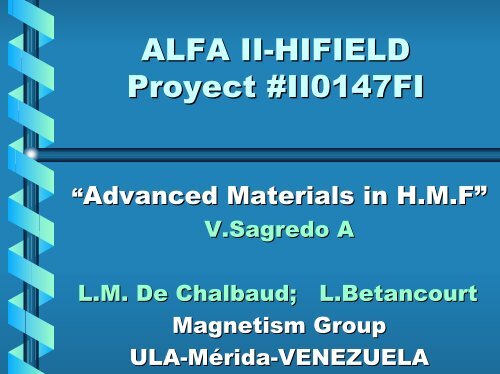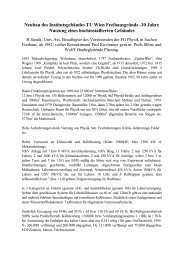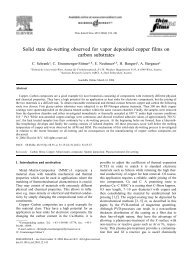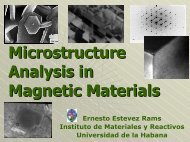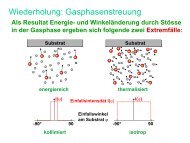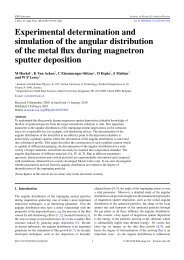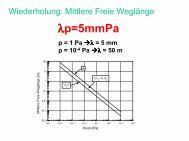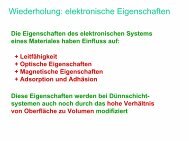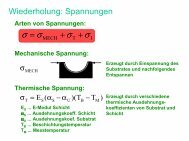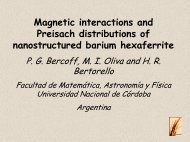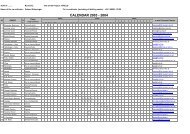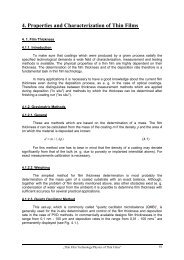ALFA II-HIFIELD Proyect #II0147FI
ALFA II-HIFIELD Proyect #II0147FI
ALFA II-HIFIELD Proyect #II0147FI
Create successful ePaper yourself
Turn your PDF publications into a flip-book with our unique Google optimized e-Paper software.
<strong>ALFA</strong> <strong>II</strong>-<strong>HIFIELD</strong><br />
<strong>Proyect</strong> #<strong>II</strong>0147FI<br />
“Advanced Materials in H.M.F”<br />
V.Sagredo A<br />
L.M. De Chalbaud; L.Betancourt<br />
Magnetism Group<br />
ULA-Mérida<br />
Mérida-VENEZUELA
Tentative research lines<br />
• A) Colossal magneto-resistance<br />
in chromium chalcogenide<br />
compounds<br />
• B) Variable range-hopping<br />
conduction in semiconductors
MAGNETORESISTANCE IN<br />
FeCr 2 S 4
MAGNETIZATION and M.S. in<br />
FeCr 2 S 4
MAGNETORESISTANCE IN<br />
MANGANITES
MAGNETIZATION IN<br />
MANGANITES
A) Colossal Magneto-Resistance<br />
The discovery of the colossal MR phenomenon<br />
in perovskite Mn oxides of .R 1-x<br />
B x<br />
MnO 3<br />
Where R: rare earth and B a divalent cation.<br />
Has generated wide attention due a variety of<br />
interesting physical properties and their potential<br />
for technological applications.<br />
In this type of materials is long known to exist<br />
the metal-insulator transition.
Important property<br />
It is important to note that CMR does not saturate<br />
until applied fields at least of the order of 6 T where<br />
the MR, when normalized to the high field resistance,<br />
can exceed that of GMR by orders of magnitude. It<br />
has been suggested that the field scale over which<br />
CMR materials can be applied will be pushed to<br />
lower values by field- amplification or spin-valve<br />
techniques.
Chromium chalcogenides<br />
A.P.Ramirez et. Al in Science (97) proposed<br />
investigate spinel structure chalcogenide compounds<br />
with composition AB 2<br />
X 4<br />
where A and B are<br />
transition elements occupying tetrahedral and<br />
octahedral sites respectively and X is a chalcogen.<br />
FeCr 2 S 4
Differences from perovskite oxides<br />
i) There are many ferromagnetic members of this<br />
family, there is the possibility of varying both<br />
anion as well cation species while maintained the<br />
spinel structure.<br />
ii<br />
Unlike in the perovskite where the A-cation<br />
acts mainly to donate charge and control the unit<br />
cell volume, in the spinels it is common to have<br />
A-cation derived states near the Fermi level.
B) Variable range hopping<br />
conduction in semiconductors<br />
Chromium diluted chalcogenide<br />
compounds as FeCr 2-x Al x S 4 have<br />
shown that Al favors the fluctuation<br />
of Coulomb potential.<br />
This effect produces an increase of<br />
resistivity and the transport behavior<br />
transits from MP transport to the<br />
VRH process
Cr based chalcogenide<br />
spinels<br />
FeCr 2 S 4<br />
CoCr 2 S 4<br />
Diluted ACr 2-x <strong>II</strong>I x S 4 compounds<br />
Examples: CdCr 2-x Ga x Se 4<br />
CdCr 2-x In x S 4


